Plugging the gap from above
Africa is uniquely placed to trade with growing markets in the East, established markets in the West, and domestic markets on her own continent. In order to benefit from the ensuing economic advantages, the continent’s financial institutions have started to tackle the unmet demand of Africa’s trade finance gap, currently estimated at US$120 billion by the African Development Bank (AfDB).
A number of wholesale trade finance initiatives have been brought to the fore, aimed at unlocking intra-regional trade to boost economic growth. But emerging technology offers a timely opportunity to anchor the continent’s top-down approach with a nimble, efficient and bottom-up solution.
From a distance, these headline-grabbing initiatives appear to have understood the root cause of the challenge and seem to be taking the necessary steps to address it. However, when we look closer at the market data, a different picture emerges.
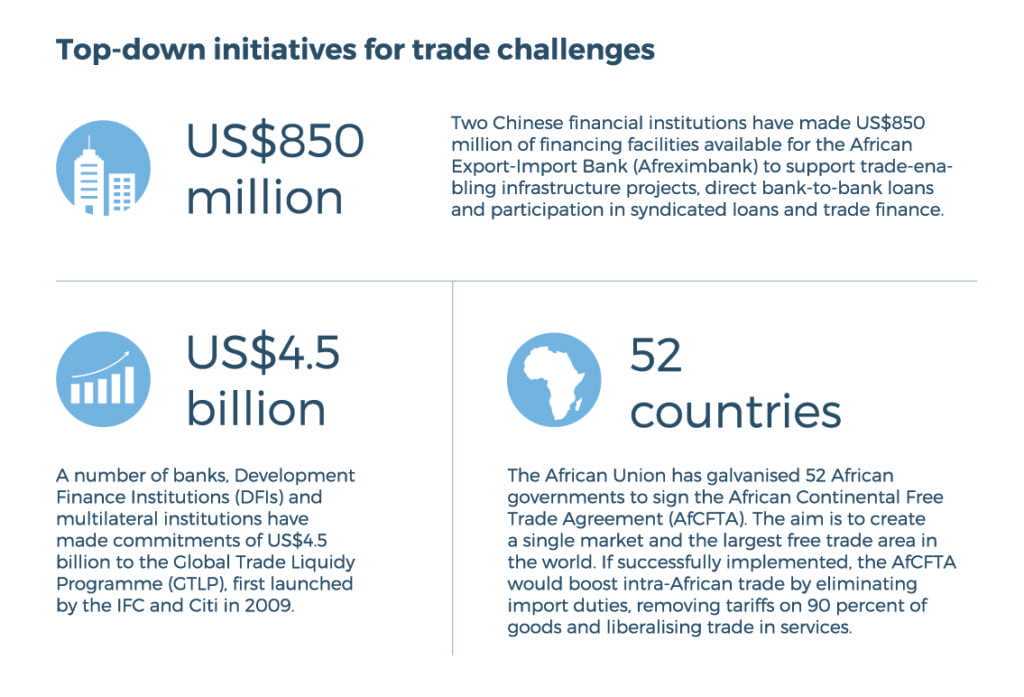
Finding the African trade finance gap
The traditional overdependence on banks has led to a skewed distribution of funding to the continent’s growing trading businesses.
Domestic and international banks still account for over 30 percent of total trade transactions in Africa, while the amount of bank-intermediated trade finance devoted to intra-African trade is estimated at just 20 percent of the continent’s total trade, according to the AfDB.
Large African corporates absorb the lion’s share of this trade finance while small and medium-sized enterprises (SMEs) and first-time applicants face significant challenges in accessing credit facilities from banks.
Options to meet the growing demand
The continent’s leaders and investment professionals have several options for tackling the trade finance gap.
Much of the attention to date has either been on the already-bankable, large African corporations or the international companies with banking lines overseas. Little has been said about the SMEs who are locked out of their local banking systems with limited access to alternative funding options abroad.
SMEs are often the backbone of economies and African countries are no different. The World Bank estimates that SMEs contribute up to 60% of total employment and 40% of GDP in emerging economies.
With this in mind, we are of the opinion that by zooming in to understand the obstacles to trade faced by SMEs in Africa, it is possible to develop bottom-up solutions to address these challenges.
Digital solutions have a key role to play in closing the trade finance gap. To date, there has been a lack of discussion about how key players within the ecosystem can leverage technology to improve access to trade finance in Africa.
But technology alone cannot be a panacea and will need the support of a multifaceted and unified approach. This will require combining the efforts of local and international banks with the broader influence of multilateral institutions.
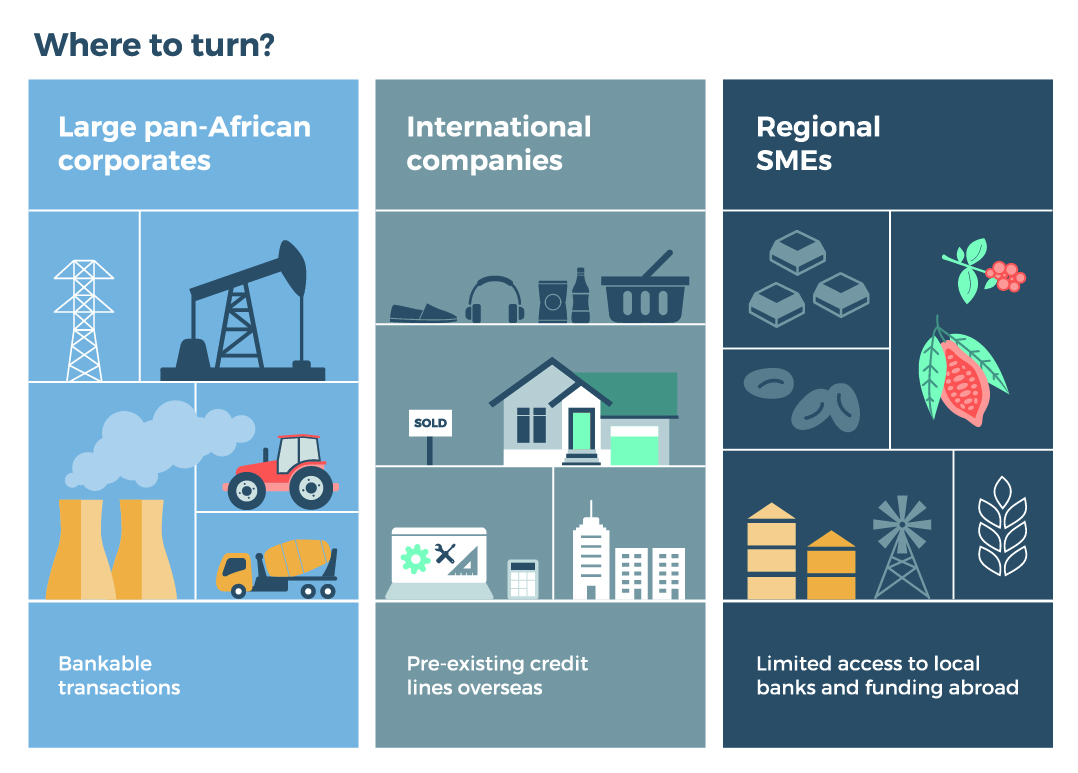
Accessing Trade Finance in Africa: the barriers for SMEs
Africa is fundamentally a trading continent. The socio-economic structure of most African countries hinges on trade. Despite recent and concerted efforts to diversify economies, trade still accounts for 51 percent of Africa’s GDP according to World Bank data.
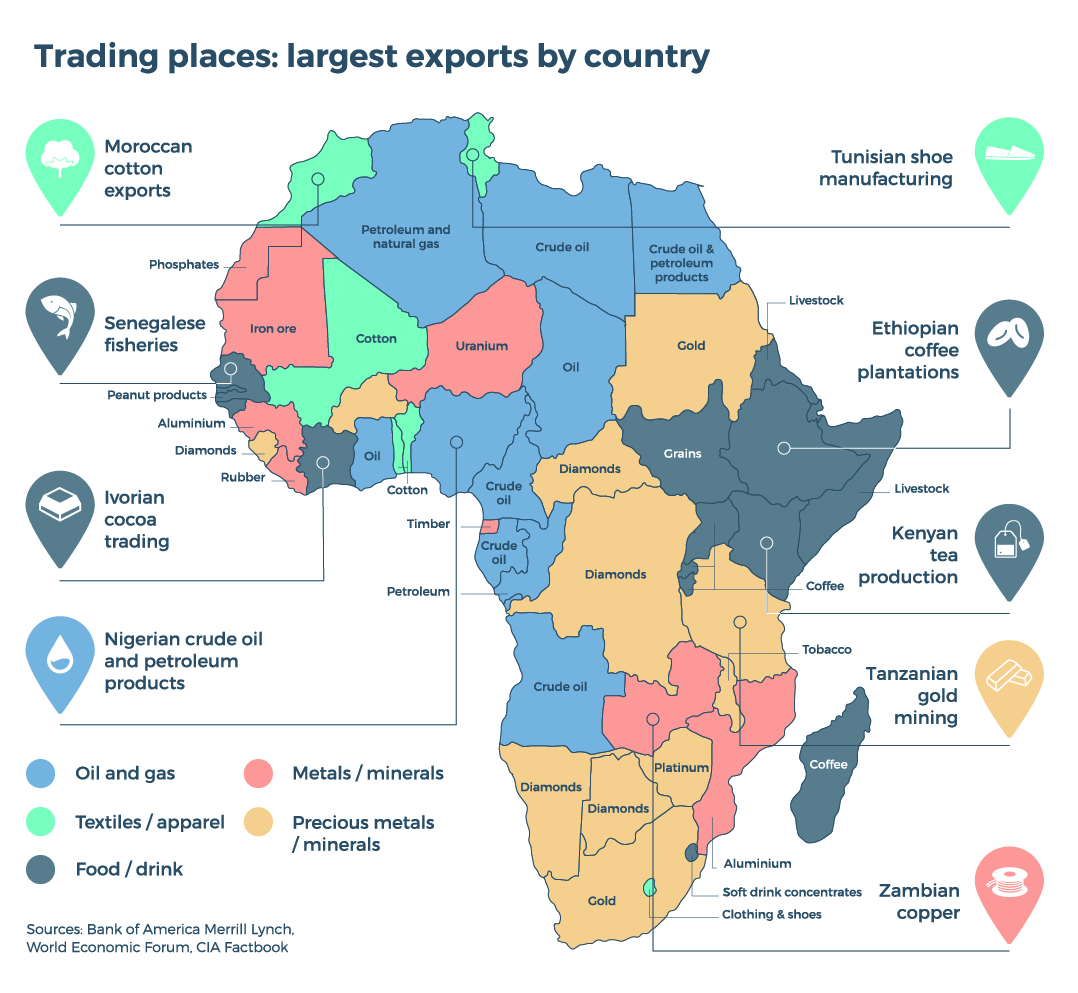
African trade finance is growing, and SMEs should be best placed to account for a significant proportion of this uptick
A recent report by Bain & Company (see below) forecasts intra-Africa trade to grow at 5.3 percent between 2016 and 2026. SMEs, and in particular businesses with revenues of over US$1 million, are expected to account for a significant percentage of this growth. These enterprises contribute to a large proportion of Africa’s trade, but even though 88 percent of African SMEs have a bank account, only 25 percent have a loan or a line of credit (AfDB). A similar IFC report calculated the finance gap (across all types of finance) for the 44 million micro, small and medium-sized enterprises (MSMEs) in sub-Saharan Africa to be US$331 billion.
What’s causing this gap?
There are several reasons for the difficulties faced by SMEs in accessing trade finance:
- High complexity and low-scale nature of most Africa-based SME trades
- Poor documentation and a lack of client credit data
- Lack of depth in financial skills and tools to identify options and execute a successful funding process
- Limited resources and knowledge in engaging a specialist team of advisers to support the fundraise process
There are also a number of other constraints from traditional banks that restrict access to trade finance for growing businesses:
- Stringent and often drawn-out
credit assessment periods - Rigid conditions relating to scale
- Unmanageable collateral requirements
- High cost of capital, especially when US dollar-denominated
The number and range of limiting factors that prevent businesses from accessing Trade Finance, as highlighted by African SMEs themselves (see below), presents a structural challenge for banks and other traditional lenders. The provision of capital, therefore, becomes high cost, high risk and low margin.
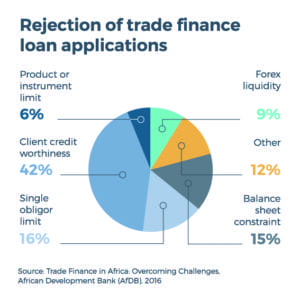
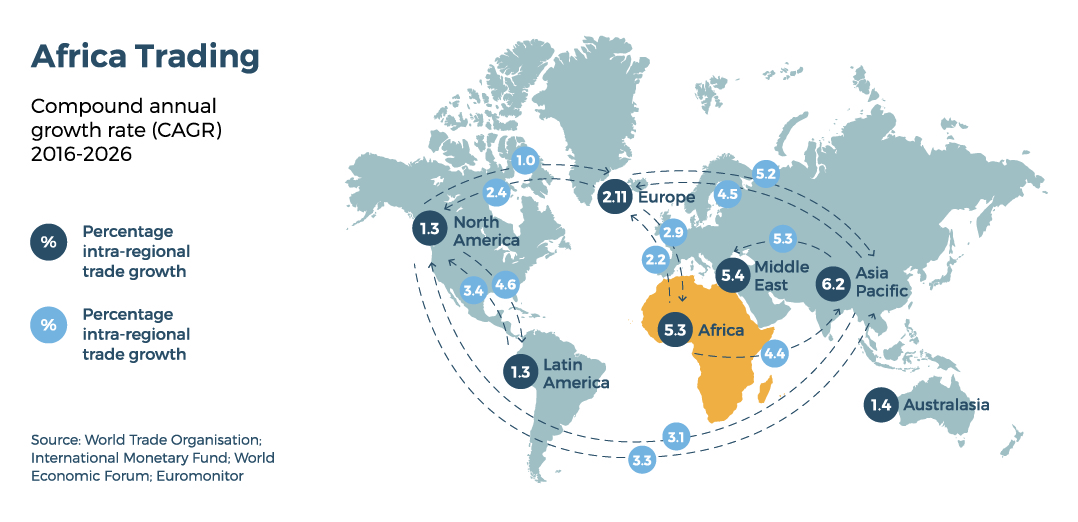
Financing African trades: Can’t bank on the banks
Banks are the most important source of finance for businesses in Africa, much the same as in the world’s most developed economies.
The AfDB’s recent survey of 900 African banks revealed that over 30 percent of the continent’s total trades are bank-financed. An estimated 68 percent of these trades were off-balance sheet (OBS) transactions, such as letters of credit (LC). The remaining 32 percent of activity was on-balance sheet transactions such as short-term loans.
But the traditional relationship-based corporate banking model is costly to operate when dealing with medium-sized businesses and smaller loan tickets. This explains why most SMEs struggle to access the required funding to support the growth of their business despite having a bank account. Neither international nor local banks are able to invest in relationships with these SMEs because lending is often costly and at times uneconomical. As a result, the continent’s more established businesses receive the lion’s share of available finance.
The issue is often more complex than simple banking economics. In many cases the fundraise process is frustrated and often blocked by an information asymmetry. This is due in part to a lack of supporting financial information which limits the bank’s ability to offer lending facilities to SMEs. Smaller businesses may lack the required data such as a credit history or audited statements. An absence of these records prevents banks from assessing the cash flow situation of any given company.
Banks are also focusing on their most profitable clients in light of international banking regulations. As well as a need to comply with strict due diligence requirements, banks must hold higher levels of capital reserves to offset the risks they take. The Basel III reforms have reduced the amount of capital that banks are able to lend. The losers here are the smaller and less profitable business lines, in other words ,the SMEs.
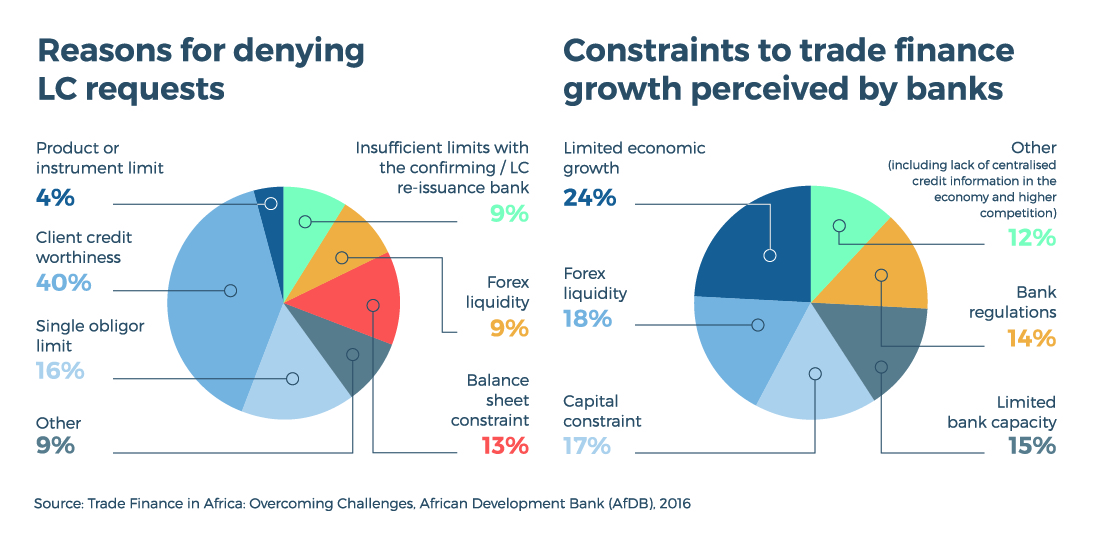
Alternative lenders: a growing asset class
The combination of growing SME demand for trade finance and the constraints faced by African banks is a major contributing factor to the emergence of private credit as an
asset class in Africa.
Taking on debt to grow the business is becoming increasingly attractive to African company owners, especially among low-cap to mid-cap companies. This is due in part to a wider range of financing options that have been relatively inaccessible to businesses across Africa up until recently. Alternative lenders are frequently able to offer funding at 18 percent – as opposed to a bank that may offer 25 percent – which is eminently appealing for a business looking to raise capital.
The burgeoning opportunity for investors
Investors are also seizing the chance to deepen Africa’s trade finance landscape by providing credit-constrained businesses with the required type of capital for growth. This is more attractive given the lower risk profile of short-term financing as a result of increasingly lower rates of default. Regardless of the size of the opportunity, institutional investors, banks, importers and exporters face the challenge of assessing and finding the right counterparty during the investment process. This is further complicated when African company owners don’t know where to start looking for investors, and even greater for those seeking their first sizable credit facility.
Enter trade technology
We see the potential for all parties within this ecosystem to leverage technology.
In removing friction points and repeated processes, Africa-focused investors, intermediaries and businesses can reduce their overall transaction costs. This is applicable across the transaction cycle from deal origination through to due diligence and transaction management up to deployment and portfolio management. As much as technology can provide the necessary tools to save time and improve efficiency, it also opens up the possibility for banks and non-bank players to better collaborate on deals, thus improving and increasing capital deployment.

Minding the gap: technology as a bridge
It’s time for a broad-based discussion on how to leverage the network effects of technology to address some of the structural and economic issues within the industry.
Technology is widely used to support the internal trade finance processes of African banks, DFIs and alternative lenders. The digital tools that they deploy range from Microsoft’s basic suite of programs to the more sophisticated systems such as Ecobank’s OMNI eFSC (Electronic Financial Supply Chain) software. However, these solutions exist in silos with disjointed usage and application.
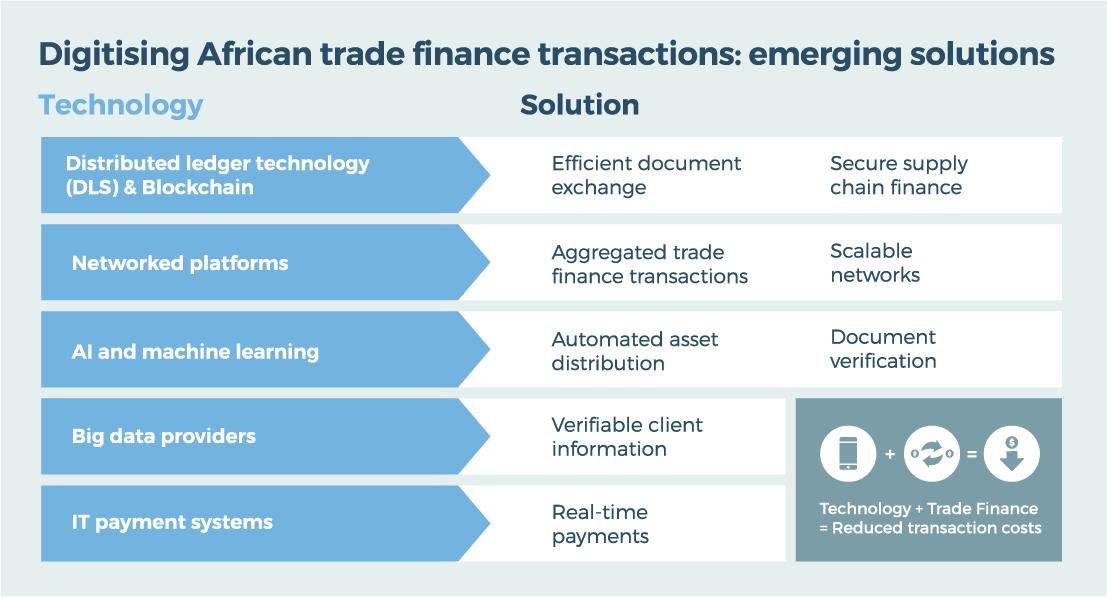
Data: company and credit data
The current deficit in accessible company information and credit history data is a challenge for funders. As more data and credit information on African businesses is made available in an intelligible form to banks and alternative lenders, the gap between perceived and actual risk starts to narrow and more funding can be made available to these enterprises. Innovative startups such as Asoko Insight, Matchdeck and Fraym alongside the more established players like Moody’s are building out valuable pools of information for the industry.
Blockchain
According to Bain & Company, the application of blockchain could increase global trade volumes from the current levels of US$1.1 trillion to US$16 trillion by 2026.
The reasoning behind this outlook is the ability of blockchain to eliminate paper-based processes, minimise fraud risks in letters of credit (LCs) and reduce the average African trade transaction lifecycle from 20 days to under 24 hours.
In 2016, using the Wave platform, Barclays Africa became the first organisation in the world to execute a live trade using blockchain technology. This verified ownership and transaction-related documents in under 4 hours (and therefore goods) for the trade of cheese and butter between Ireland and Seychelles.
Similarly, HSBC and ING carried out the first commercially viable trade finance transaction via blockchain in 2018 using R3’s Corda software. A letter of credit for the soybean trade between Argentina and Malaysia was executed on a single shared platform, taking under 24 hours to complete after the details were shared between the banks.
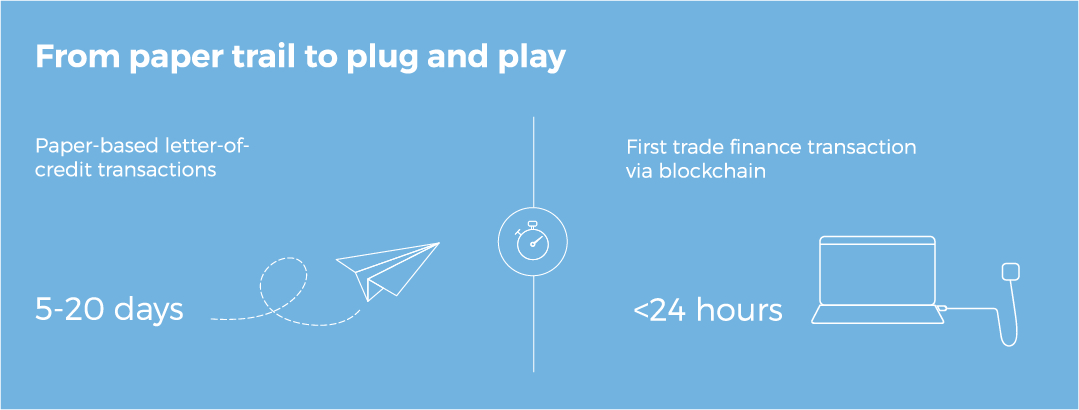
IT payment systems
The free flow of goods and services is a key factor in increasing intra-African trade. Nonetheless, of equal importance is the velocity and efficiency of financial flows between neighbouring countries, regions and institutions.
Initiatives such as Afreximbank’s Pan-African Payment and Settlement Platform (PAPSP) will be crucial in meeting the targets of the AfCFTA. The system is aimed at lowering transaction costs and supporting informal cross-border trade, currently estimated at US$93 billion.
On a regional level, the Southern Africa Development Community (SADC) launched their Integrated Regional Electronic Settlement System (SIRESS) to settle payments between participating banks in South African Rand. According to SWIFT, since inception in 2013, 83 participants have carried out 712,099 transactions on the system with a total value of 3,100 billion rand. This has resulted in faster settlement time, reduced settlement risk and lower transacting costs.
The region is also making good progress towards the creation of a multi-currency payment system, with the United States dollar expected to become the second currency of settlement during 2019.
AI and machine learning
Although African Trade Finance is some way off achieving a transformation through AI, its usage has progressed at a rapid rate within the banking industry. Natural language processing and AI technology have witnessed higher adoption in retail banking, such as ABSA and UBA’s recently launched chatbots. But AI will no doubt become increasingly important in terms of automation, cost reduction and increasing efficiency for trade finance.
With improved access to company data, deep machine learning should arm trading partners with transparency and predictability and provide a greater capacity to identify potential noncompliance, anti-money laundering (AML) and fraud risks.
Networked platforms
It’s strange to think that we once lived in a world of island messaging systems.
Prior to the proliferation of SWIFT (The Society for Worldwide Interbank Financial Telecommunication), each bank had its own messaging system which meant that it could take several days to communicate payment confirmations between banks and businesses.
SWIFT now has a network of over 11,000 financial institutions in more than 200 countries and territories who are exchanging on average over 15 million messages per day.
The economic benefit of the SWIFT network effect is clear to see.
Tech-enabled trade aggregation
The African trade finance ecosystem can use SWIFT as an inspiration to adopt a single networked platform. Banks should be able to leverage algorithms and smart matching technology to originate transactions and syndicate loans with other non-bank lenders under the same digital roof. A valuable network should also allow lenders to source insurance wraps from intermediaries, hedge foreign exchange exposures, place forward orders with brokers and secure logistics providers.
The transformative power of such a network can plug a significant percentage of Africa’s trade finance gap. Transaction time will reduce by eliminating the long turnaround times in moving documents between trade service providers, banks, government bodies and logistics companies.
More importantly, platforms can aggregate the smaller trades that are currently off-limits for many Africa-focused financiers. Uneconomical trades across the continent then become viable and profitable.
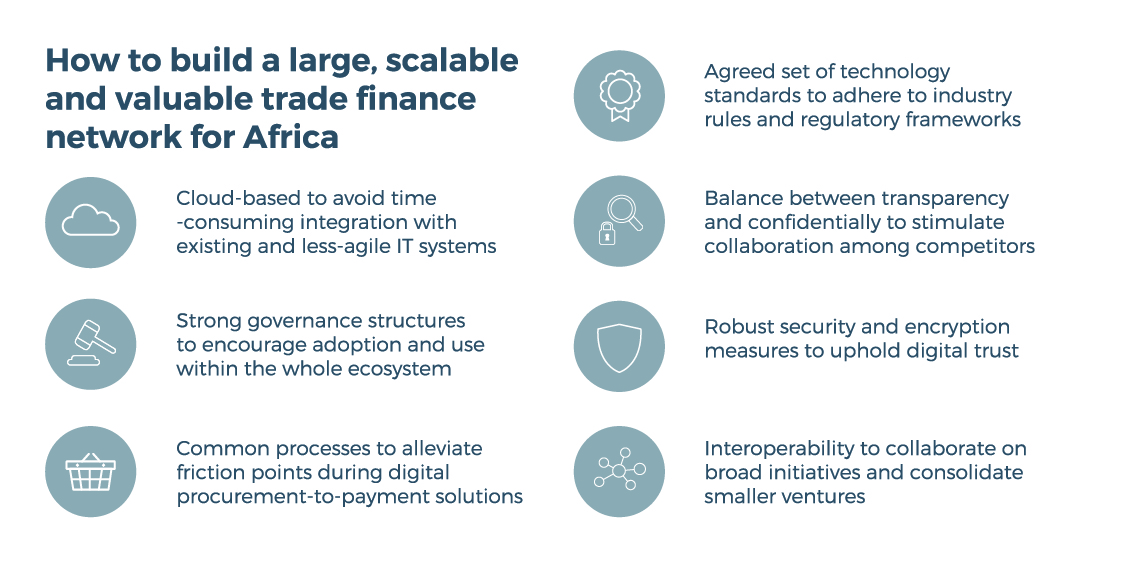
Help from above – a role for SuperNodes
There isn’t a one-size-fits-all technology solution to Africa’s trade finance gap. Networked platforms need collaboration and significant investment from all the participants in the ecosystem. For Africa, this means the banks, DFIs and government bodies. A strong digital trade network would also encompass the regulators, trading companies, logistics hubs, shipping firms,, financial service providers and customs authorities.
The onus should fall on multilateral institutions to take the responsibility and assume roles of
‘supernodes’. The best-placed organisations to do this are the DFIs (inherently development-focused) and large banks (capital-abundant).
These actors have the sufficient scale to coordinate and invest in technologies that can help them attain the penetration they are mandated to realise. As a by-product of increasing access to shared financing and collateral information, the network will be able to help its individual participants reduce their risk for future transactions.
A ‘supernode’ should also be able to share information between a regional bank, government port and company network. The company network tracks the flow of goods and customs documentation; the bank tracks relevant data to the borrower and end buyer.
The potential to increase intra-African and inter-regional trade using this approach is substantial. Especially when we envisage that these processes can take place within a networked platform using blockchain technology, leveraging Africa-focused data resources and implementing smart payments solutions.
The time is now
Trade remains the cornerstone of African economies and contributes 51 percent of the continent’s total GDP per year. The widening trade finance gap needs to be bridged with a multifaceted approach.
Banks, DFIs, traders and governments should recognise that adopting new technologies is a critical pillar to addressing this gap. By bringing a digital-first approach to the top of the agenda, all parties within the ecosystem can harness the benefits.
An economic area is no longer defined by traditional boundaries, rather by digital data flows, and Africa needs to digitise its Free Trade Area to enable it to incorporate at scale. Many countries across the continent have already proved that they can leapfrog development in other areas.
With technology as a driver and institutional support as a mechanism, Africa has the chance to set the pace for the future of trade across the world.



